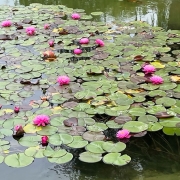When We Talk of Love…
When we fall in or or what we initially think is love, it’s often our own love being mirrored back to us via another person. For those of us not strongly in touch with our essence and sense of worth, it can be as if this outside force is bringing us to life. (Of course this, coupled with all the dopamine and oxytocin that get activated in early romance further this heightened sensation of pleasure coming from an external source). It is also a real phenomenon that connection with others, when it is good, increases happiness. That is not a mirage. We are social creatures longing for a balance of union and autonomy. It’s nourishing to feel support, validation, love and respect from someone else and it often lighten’s one’s load to be interdependent, sharing activities and responsibilities.
When that outside source withdraws, as it so often does in contemporary relationships through divorce, break ups, and/or an unwillingness to be involved beyond the initial thrill of hooking up, two people are left to feel their independent essence again without the presence of the other. Any kind of separation constitutes an initial reconfiguration of self- be it a sigh of relief or a cry of loneliness and loss, or both.
What is interesting to note though is that in a healthy person, that sense of being vibrant and beautiful remains. It doesn’t withdraw just because the person mirroring it back stops loving or engaging with you. Unfortunately, without anyone to give your essence to in relationship, you might tuck it into yourself a little protectively, holding it close to your skin. But it is still there. Do not let it die. Or extinguish it. It’s your gift to the world.
And do not apologize for sharing and sending it out to someone previously. It is beautiful and natural to give and receive love. And sometimes, it’s a rare opportunity, but it is why we are here. Because of wounding over the course of our lives though, we might feel inhibited and defensive. Vulnerability takes courage. It is also often shunned as needy. Yet the irony is that people don’t tend to be needy when their basic needs are met.
It is okay to be human and to have needs. Projecting our needs onto an unwilling party is an intrusion but to have needs is part of being alive and living with an open heart.
I once heard that people are most attractive when fiercely independent. And while that might be true, for a strong confident individual reflects a degree of psychological autonomy and maturity, independence can also be a decoy for indifference and not caring. It can be a cover for rigidity and cowardice as well. Or not knowing how to maintain healthy boundaries.
Love of self and love of other can create polarities at times. It is not always an easy tension to maintain. But it doesn’t have to be rocket science either. Instead it is an art form of together/apart and apart/together that evolves over time and with care.

